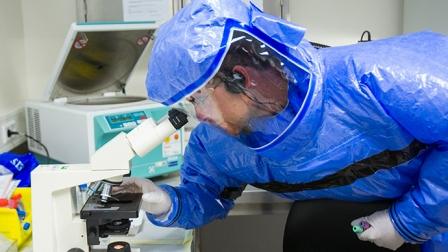Without better containment of the Ebola outbreak, there could be 550,000 to 1.4 million cases in Liberia and Sierra Leone by January, according to a new estimate published today by the U.S. Centers for Disease Control and Prevention.
The range is based on how well, or badly, cases have been reported, the CDC said in statement. It also assumes a significant failure of public health efforts and a lack of additional resources to control the outbreak.
“The findings in this report underscore the substantial public health challenges posed by the predicted number of future Ebola cases,” the researchers wrote in the estimate. “If conditions continue without scale-up of interventions, cases will continue to double approximately every 20 days, and the number of cases in West Africa will rapidly reach extraordinary levels.”
The CDC said it revised earlier estimates upward after adding in an assumption that the number of cases is “significantly underreported.” The model does not account for the ongoing U.S. government Ebola relief effort.
There are 4.3 million people in Liberia and 6.1 million people in Sierra Leone. The model doesn’t includeGuinea, because the number of cases there has fluctuated too much to make modeling valid, the CDC said.
Isolation Needs
“The model shows several things that are really, I think encouraging and one cautionary note,” said Tom Frieden, the director of the CDC, on a conference call today. “If you get enough people effectively isolated, the epidemic can be stopped. When you reach a high enough number, the number of cases plummets rapidly, almost as rapidly as the exponential rise we’re seeing now.”
Another estimate released today by the World Health Organization predicted that there could be 21,000 cases of the virus by November if control efforts in Western Africa aren’t quickly increased.
That analysis, made by the World Health Organization’s Ebola response team, was published in the New England Journal of Medicine. Presuming no additional aid, the model forecasts 9,939 cases in Liberia, 5,925 cases in Guinea, and 5,063 in Sierra Leone by Nov. 2, more than three times the current total.
“Without drastic improvements in control measures, the number of cases of and deaths from Ebola virus disease are expected to continue increasing from hundreds to thousands per week in the coming months,” the WHO researchers wrote.
Relief Agencies
Relief agencies and governments last week renewed efforts to hasten aid, including a $1 billion commitment from the U.S. and the creation of a United Nations special emergency mission.
Since the start of the outbreak, the virus has infected 5,864 people, killing 2,811, according to a Sept. 22 WHOreport. It has spread through five West African nations, accelerating in cities, including Monrovia, the capital of Liberia.
The researchers warned of the possibility that Ebola “will become endemic among the human population of West Africa, a prospect that has never previously been contemplated.”
While the spread of the disease was helped by highly interconnected populations and heavy cross-border traffic between Guinea, Liberia and Sierra Leone, “a large outbreak was not inevitable,” the researchers said, pointing toNigeria, which has strong health systems and has limited the number of cases despite the introduction of Ebola in Lagos and Port Harcourt, both large cities.
‘Exceptionally Large’
“The present epidemic is exceptionally large, not primarily because of biologic characteristics of the virus, but in part because of the attributes of the affected populations, the condition of the health systems, and because control efforts have been insufficient,” Christopher Dye, co-author of the study and director of strategy for WHO, said in a statement.
The outbreak has affected men and women equally, and killed 71 percent of people who were tracked by the health system, the study found. The actual fatality rate is probably lower, since not every infected person went to see a doctor.
While experimental vaccines and drugs are being explored, they “are unlikely to be available in the quantities needed to make a substantial difference in control effort for many months,” the researchers said.
Instead, resources should be focused on improving control measures, such as adding beds in clinics and keeping better track of those who may have been infected, researchers said.
There is no cure for Ebola, which is spread by contact with the blood and bodily fluids of those infected. The disease normally is treated by keeping patients hydrated, replacing lost blood and using antibiotics to fight infections. The hope is that a patient’s immune system will fight off the aggressive attack of the virus
via@Bloomberg



Leave a Reply